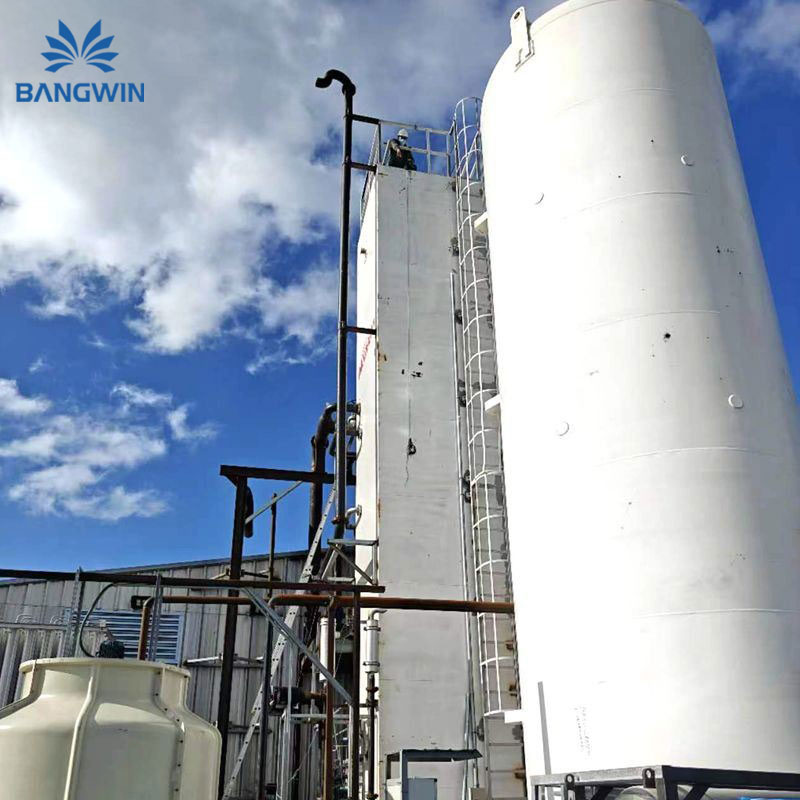Air separation is a crucial process that allows for the extraction of essential gases such as oxygen, nitrogen, and argon from the atmosphere. These gases play vital roles in various industrial, medical, and technological applications. In this blog, we will delve into the detailed process of air separation, focusing on how oxygen, nitrogen, and argon are efficiently separated and utilized. We'll also highlight the role of air separation plants and related products offered by Bangwin Gas.
Introduction to Air Separation
Air is a mixture of gases, primarily composed of nitrogen (78%), oxygen (21%), argon (0.93%), and small amounts of other gases. The air separation process leverages the unique boiling points of these gases to separate them efficiently. This separation is predominantly achieved through cryogenic distillation, a method that involves cooling the air to extremely low temperatures.
The Air Separation Process
The air separation process can be broken down into several critical stages:
-
Air Compression:
- Ambient air is first drawn into the system and compressed using multi-stage compressors. This increases the air pressure, preparing it for subsequent purification and cooling stages.
-
Air Purification:
- The compressed air passes through purification units to remove impurities such as moisture, carbon dioxide, and hydrocarbons. This step is essential to prevent freezing and blockages in the cryogenic distillation columns.
-
Cooling and Liquefaction:
- The purified air is then cooled using heat exchangers, where it exchanges heat with outgoing product and waste streams. The air is cooled to cryogenic temperatures, typically below -180°C, causing it to liquefy.
-
Cryogenic Distillation:
- The liquefied air is fed into a high-pressure distillation column. Here, the air mixture is separated based on the different boiling points of its components:
- Nitrogen: With the lowest boiling point (-196°C), nitrogen rises to the top of the column.
- Oxygen: With a higher boiling point (-183°C), oxygen is collected at the bottom of the column.
- Argon: Argon, with a boiling point of -186°C, is extracted between the nitrogen and oxygen collection points through additional distillation columns.
-
Product Collection and Purification:
- The separated gases are collected in their respective forms (liquid or gas). Further purification steps may be applied to achieve the desired purity levels for specific applications.
Air Separation Plants
Air separation plants are specialized facilities where the process of air separation is carried out. These plants are equipped with advanced technology to ensure efficient and high-purity gas production. At Bangwin Gas, we offer state-of-the-art air separation plants designed to meet the rigorous demands of various industries. Our plants are known for their reliability, efficiency, and ability to produce high-quality gases.
Products from Bangwin Gas
Bangwin Gas provides a range of products related to air separation, including:
- PSA Oxygen Generators: These units produce high-purity oxygen for medical, industrial, and scientific applications.
- PSA Nitrogen Generators: Our nitrogen generators are designed to deliver high-purity nitrogen for use in food packaging, electronics manufacturing, and inerting processes.
- PSA (Pressure Swing Adsorption) Systems: These systems are used for both oxygen and nitrogen generation, utilizing advanced adsorption technology to separate gases.
- Cryogenic Air Separation Plants: These plants are capable of producing large quantities of high-purity oxygen, nitrogen, and argon, making them ideal for industrial applications.
Applications of Separated Gases
The gases separated through this process have a wide range of applications across various industries:
-
Oxygen:
- Steel Manufacturing: Oxygen is used in blast furnaces to enhance combustion efficiency and reduce carbon content.
- Healthcare: Medical-grade oxygen is crucial for respiratory therapy, anesthesia, and life support systems.
- Chemical Industry: Oxygen is used in oxidation reactions and wastewater treatment processes.
-
Nitrogen:
- Food and Beverage: Nitrogen is used for food packaging to displace oxygen, thus extending shelf life.
- Electronics: High-purity nitrogen is used in semiconductor manufacturing for processes like inerting and purging.
- Oil and Gas: Nitrogen is used for pressure testing, enhanced oil recovery, and inerting tanks.
-
Argon:
- Welding and Metal Fabrication: Argon provides an inert atmosphere for welding, preventing oxidation and contamination.
- Electronics: Argon is used in the production of semiconductors and other electronic components.
- Lighting: Argon is used in light bulbs and fluorescent tubes to prevent the oxidation of the filament.
Conclusion
The air separation process is a sophisticated and efficient method for extracting oxygen, nitrogen, and argon from the atmosphere. By utilizing cryogenic distillation, these essential gases can be separated and purified to meet the needs of various industries. Understanding this process highlights the importance of advanced technology in providing critical support for industrial, medical, and technological applications.
Through continuous innovation and improvement, air separation units (ASUs) ensure a reliable and high-quality supply of these gases, contributing significantly to the advancement and sustainability of numerous sectors. At Bangwin Gas, we are committed to delivering cutting-edge air separation solutions and products that meet the diverse needs of our clients worldwide.



